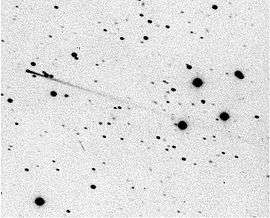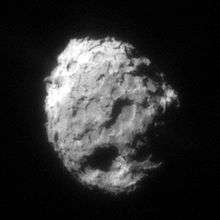7968 Elst–Pizarro
|
7968 Elst–Pizarro imaged at La Silla Observatory in August 1996. The narrow tail is visible. | |
| Discovery | |
|---|---|
| Discovered by |
1979 OW7: M. R. S. Hawkins R. H. McNaught,[1] S. J. Bus [2] 1996 N2: Eric W. Elst, Guido Pizarro |
| Discovery date |
24 July 1979 (1979 OW7) [3] 14 July 1996 (1996 N2) |
| Designations | |
|
P/1996 N2 1979 OW7 | |
|
Main-belt comet [4][5] Main-belt asteroid [6] Themis/ Beagle family [4] | |
| Orbital characteristics[6] | |
| Epoch 13 January 2016 (JD 2457400.5) | |
| Uncertainty parameter 0 | |
| Observation arc | 13350 days (36.55 yr) |
| Aphelion | 3.66751 AU (548.652 Gm) (Q) |
| Perihelion | 2.6524 AU (396.79 Gm) (q) |
| 3.1600 AU (472.73 Gm) (a) | |
| Eccentricity | 0.16062 (e) |
| 5.62 yr (2051.7 d) | |
Average orbital speed | 16.64 km/s |
| 187.70° (M) | |
| 0° 10m 31.656s / day (n) | |
| Inclination | 1.3873° (i) |
| 160.14° (Ω) | |
| 131.97° (ω) | |
| Earth MOID | 1.63474 AU (244.554 Gm) |
| Jupiter MOID | 1.51427 AU (226.532 Gm) |
| Jupiter Tisserand parameter | 3.185 |
| Physical characteristics | |
| Dimensions | 3.8±0.6 km (Spitzer) [7] |
Mean density | 1.3(?) g/cm³ [8] |
| 3.471 h (0.1446 d)[6] | |
| 0.05±0.02R [7] | |
| Temperature | 160 K [8] |
| 17.24 to 20.71 | |
|
15.7[6] 15.3R (2004) [8] 15.49R (2010) [9] | |
|
| |
Comet Elst–Pizarro is a body that displays characteristics of both asteroids and comets,[10] and is the prototype of main-belt comets. Its orbit keeps it within the asteroid belt, yet it displayed a dust tail like a comet while near perihelion in 1996, 2001, and 2007.
- As a comet it is formally designated 133P/Elst–Pizarro.
- As an asteroid it is designated 7968 Elst–Pizarro.
Elst–Pizarro was reported in 1979 as minor planet 1979 OW7, with its image on a photographic plate being completely stellar in appearance. Its orbit remains entirely within the orbits of Mars and Jupiter, with eccentricity 0.165, typical of a minor planet in the asteroid belt. However, the images taken by Eric W. Elst and Guido Pizarro in 1996, when it was near perihelion, clearly show a cometary tail. Since this is not normal behaviour for asteroids, it is suspected that Elst–Pizarro has a different, probably icy, composition. The cometary nature of Elst–Pizarro was first discovered when a linear dust feature was observed with the ESO 1-metre Schmidt telescope at La Silla Observatory on 7 August 1996.[8][11]
Subsequently, around the next perihelion in November 2001, the cometary activity appeared again, and persisted for 5 months.[8]
At present, there are only four other objects that are cross-listed as both comets and asteroids: 2060 Chiron (95P/Chiron), 4015 Wilson–Harrington (107P/Wilson-Harrington), 60558 Echeclus (174P/Echeclus), and 118401 LINEAR (176P/LINEAR, previously 1999 RE70).[12] As a dual status object, astrometric observations of 7968 Elst–Pizarro should be reported under the minor planet designation.[12]
It most recently came to perihelion on 8 February 2013.[6]
References
- ↑ "MPEC 1996-R07 : COMET P/1996 N2 (ELST-PIZARRO)". IAU-Minor Planet Center. 12 September 1996.
- ↑ "IAUC 6473". IAU-Central Bureau for Astronomical Telegrams. 12 September 1996.
- ↑ "IAUC 6457". IAU-Central Bureau for Astronomical Telegrams. 21 August 1996.
- 1 2 Henry H. Hsieh (May 2010). "Main Belt Comets". Hawaii. Retrieved 2010-12-15. (older 2010 site) Archived August 10, 2009, at the Wayback Machine.
- ↑ David Jewitt. "Main Belt Comets". UCLA, Department of Earth and Space Sciences. Retrieved 2010-12-15.
- 1 2 3 4 5 "JPL Small-Body Database Browser: 7968 Elst–Pizarro (1996 N2)" (2012-06-06 last obs). Archived from the original on 9 August 2012. Retrieved 13 April 2016. from the original on 2012-08-08
- 1 2 Hsieh, Henry H.; Jewitt, David C.; Fernández, Yanga R. (2009). "Albedos of Main-Belt Comets 133P/Elst–Pizarro and 176P/LINEAR". The Astrophysical Journal Letters. 694 (2): L111–L114. arXiv:0902.3682
 . Bibcode:2009ApJ...694L.111H. doi:10.1088/0004-637X/694/2/L111. Retrieved 2010-12-17.
. Bibcode:2009ApJ...694L.111H. doi:10.1088/0004-637X/694/2/L111. Retrieved 2010-12-17. - 1 2 3 4 5 Hsieh, Henry H.; Jewitt, David C.; Fernández, Yanga R. (2004). "The Strange Case of 133P/Elst–Pizzarro: A Comet Among the Asteroids". The Astronomical Journal. 127 (5): 2997–3017. Bibcode:2004AJ....127.2997H. doi:10.1086/383208. Retrieved 2010-12-17.
- ↑ Hsieh, Henry H.; Jewitt, David C.; Lacerda, Pedro; Lowry, Stephen C.; Snodgrass, Colin (2010). "The return of activity in main-belt comet 133P/Elst–Pizarro". Monthly Notices of the Royal Astronomical Society. 403 (1): 363–377. arXiv:0911.5522
 . Bibcode:2010MNRAS.403..363H. doi:10.1111/j.1365-2966.2009.16120.x. Retrieved 2010-12-17.
. Bibcode:2010MNRAS.403..363H. doi:10.1111/j.1365-2966.2009.16120.x. Retrieved 2010-12-17. - ↑ "Main-Belt Comets May Have Been Source Of Earths Water". Space Daily. 23 March 2006.
- ↑ "Strange Comet Discovered at ESO". ESO. 16 September 1996.
- 1 2 "Dual-Status Objects". Minor Planet Center. 2008-03-06. Retrieved 2010-12-17.
External links
| Numbered comets | ||
|---|---|---|
| Previous 132P/Helin–Roman–Alu |
7968 Elst–Pizarro | Next 134P/Kowal–Vávrová |


